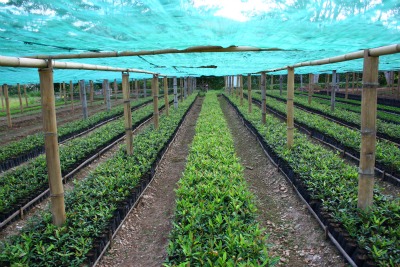Finding the Right Balance

Coffee seedlings
Planners had to factor in population growth as well. A projected growth rate of 2.4 percent, increasing urbanization and rising incomes would put ever greater strain on rice supplies. The World Bank had estimated that to achieve rice self-sufficiency by 2035, rice production would have to grow aggressively. By its calculations, production would need to increase 5 percent per year compounded, while the area irrigated would need to increase by 5 percent per year compounded up to 2020 to achieve self-sufficiency by 2035. [23] To reach self-sufficiency by 2020 would require even more dramatic production gains. Even then, if the population continued to grow at current rates, imports would need to resume in 2040. This was ambitious. Even at the peak of the Asian Green Revolution, rice yield growth rates did not exceed 3.5 percent. [24]
Agriculture policymakers would also need to factor in maternal and child nutrition. The latest Demographic and Health Survey had revealed a startling 58 percent of children under five were stunted. [25] Rice was low in protein and micronutrients, and the habit of eating a big helping of rice with very little vegetables, egg or meat had become entrenched. Planners might want to introduce a vitamin-fortified strain such as golden rice, with beta-carotene (for combatting vitamin A deficiency). [26]
The ultimate goal was to offer both farmers a sufficiently high farmgate price for paddy and consumers an affordable price per sack of rice. Other countries had used a variety of mechanisms to achieve this. They included transfer of a consumer subsidy from imported to locally produced rice; a registered voucher system for rice consumers; cash transfers made conditional on quality and minimal leakage; or co-payments to millers and rural transport services along corridors connecting rice baskets to key urban centers.
Other countries’ experience had demonstrated that investing in agricultural productivity has a multiplier effect on other sectors in the economy through consumption and production linkages. [27] For example, a rice farmer who earned additional income from selling his surplus rice would spend this income at a local kiosk; or an increase in paddy yield generated more business for a local miller and increased demand for seeds, fertilizer and farm labor.
There was also the broader question of whether it made sense for Timor-Leste to invest primarily in rice production, or instead to support a wide array of crops. Good harvests in one crop could compensate for bad harvests in another. Crop diversification would also help improve food security, and investing in produce with higher protein and vitamin content would improve household diet diversity and nutritional security. Investing in other staple crops could also reduce the rice consumption-production gap by encouraging reduced, or at least stable, levels of domestic rice consumption.
The ministers and advisors in charge of agricultural policy had much to consider. Making Timor-Leste 100 percent sufficient in rice by 2020 was an ambitious goal. Had all the factors been considered when the target was decided? Did the policy hold up under scrutiny? Could the money that it would cost be spent elsewhere more effectively? What was the optimal combination of policies and investments?
[23] World Bank (2010), Raising Agricultural Productivity: Issues and Options, Report No. 50276-TP, Technical Note No 2: Assessment of Food Self-Sufficiency in Timor-Leste, 1.
[24] Dawes, D. ‘Running Out of Steam’. Rice Today, July-September 2008, 41.
[25] Timor-Leste Demographic and Health Survey 2009-10, 150.
[26] For more on golden rice, see: IRRI, Golden Rice . http://irri.org/goldenrice.
[27] World Development Report 2008, 34.